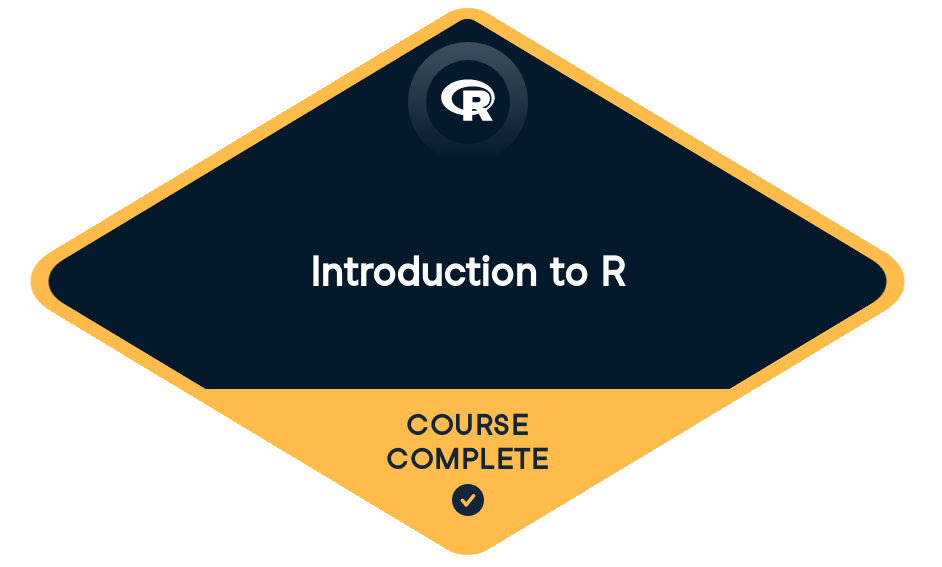
Loved by learners at thousands of companies
Course Description
Learn R Programming
R programming language is a useful tool for data scientists, analysts, and statisticians, especially those working in academic settings. R's ability to handle complex analyses such as machine learning, financial modeling, and more makes it a valuable asset for a wide range of data-related tasks.This introduction to R course covers the basics of this open source language, including vectors, factors, lists, and data frames. You’ll gain useful coding skills and be ready to start your own data analysis in R.
Gain an Introduction to R
You’ll get started with basic operations, like using the console as a calculator and understanding basic data types in R. Once you’ve had a chance to practice, you’ll move on to creating vectors and try out your new R skills on a data set based on betting in Las Vegas.Next, you’ll learn how to work with matrices in R, learning how to create them, and perform calculations with them. You’ll also examine how R uses factors to store categorical data. Finally, you’ll explore how to work with R data frames and lists.
Master the R Basics for Data Analysis
By the time you’ve completed our Introduction to R course, you’ll be able to use R for your own data analysis. These sought-after skills can help you progress in your career and set you up for further learning. This course is part of several tracks, including Data Analyst with R, Data Scientist with R, and R Programming, all of which can help you develop your knowledge.Training 2 or more people?
Get your team access to the full DataCamp platform, including all the features.- 1
Intro to basics
FreeTake your first steps with R. In this chapter, you will learn how to use the console as a calculator and how to assign variables. You will also get to know the basic data types in R. Let's get started.
- 2
Vectors
We take you on a trip to Vegas, where you will learn how to analyze your gambling results using vectors in R. After completing this chapter, you will be able to create vectors in R, name them, select elements from them, and compare different vectors.
Create a vector100 xpCreate a vector (2)100 xpCreate a vector (3)100 xpNaming a vector100 xpNaming a vector (2)100 xpCalculating total winnings100 xpCalculating total winnings (2)100 xpCalculating total winnings (3)100 xpComparing total winnings100 xpVector selection: the good times100 xpVector selection: the good times (2)100 xpVector selection: the good times (3)100 xpVector selection: the good times (4)100 xpSelection by comparison - Step 1100 xpSelection by comparison - Step 2100 xpAdvanced selection100 xp - 3
Matrices
In this chapter, you will learn how to work with matrices in R. By the end of the chapter, you will be able to create matrices and understand how to do basic computations with them. You will analyze the box office numbers of the Star Wars movies and learn how to use matrices in R. May the force be with you!
What's a matrix?100 xpAnalyze matrices, you shall100 xpNaming a matrix100 xpCalculating the worldwide box office100 xpAdding a column for the Worldwide box office100 xpAdding a row100 xpThe total box office revenue for the entire saga100 xpSelection of matrix elements100 xpA little arithmetic with matrices100 xpA little arithmetic with matrices (2)100 xp - 4
Factors
Data often falls into a limited number of categories. For example, human hair color can be categorized as black, brown, blond, red, grey, or white—and perhaps a few more options for people who color their hair. In R, categorical data is stored in factors. Factors are very important in data analysis, so start learning how to create, subset, and compare them now.
- 5
Data frames
Most datasets you will be working with will be stored as data frames. By the end of this chapter, you will be able to create a data frame, select interesting parts of a data frame, and order a data frame according to certain variables.
What's a data frame?100 xpQuick, have a look at your dataset100 xpHave a look at the structure100 xpCreating a data frame100 xpCreating a data frame (2)100 xpSelection of data frame elements100 xpSelection of data frame elements (2)100 xpOnly planets with rings100 xpOnly planets with rings (2)100 xpOnly planets with rings but shorter100 xpSorting100 xpSorting your data frame100 xp - 6
Lists
As opposed to vectors, lists can hold components of different types, just as your to-do lists can contain different categories of tasks. This chapter will teach you how to create, name, and subset these lists.
Training 2 or more people?
Get your team access to the full DataCamp platform, including all the features.In other tracks
R Programming Fundamentalsdatasets
Course GlossaryCo-founder of DataCamp
Jonathan Cornelissen is one of the co-founders of DataCamp and the initial DataCamp CEO, and is interested in everything related to data science, education and entrepreneurship. He holds a PhD in financial econometrics, and was the original author of an R package for quantitative finance.
More information at: jonathancornelissen.com
Follow @cornelissenjo or here
Read on Medium
Connect on Linkedin
More information at: jonathancornelissen.com
Follow @cornelissenjo or here
Read on Medium
Connect on Linkedin
Join over 18 million learners and start Introduction to R today!
Create Your Free Account
or
By continuing, you accept our Terms of Use, our Privacy Policy and that your data is stored in the USA.